Xarelto and Warfarin are two of the most commonly used drugs to prevent and treat blood clots in patients with a history of Deep Vein Thrombosis (DVT), Pulmonary Embolism (PE), and atrial fibrillation. With the same function to treat blood clots, what is the difference between Xarelto and Warfarin? Find the answer in this post!
Blood-thinning Drugs and Their Benefits for Treating Blood Clots
Over the years, the Food and Drug Administration or FDA has approved several blood-thinning drugs, including Xarelto and Warfarin. However, both of these anticoagulant drugs have the same function or benefit, which is to reduce a person’s chances of having a stroke due to blood clots.
As well as benefits, anticoagulant drugs such as Xarelto and Warfarin also have side effects, both serious and non-serious. Despite having the same benefits and side effects, it has a difference between Xarelto and Warfarin that you should know.
Difference Between Xarelto and Warfarin: What is Xarelto?
Before you understand the difference between Xarelto and Warfarin, it’s good to know about both of them first. Let’s start with Xarelto. Xarelto also known as rivaroban is an anticoagulant drug that was approved by the Food and Drug Administration or FDA in July 2011.
In general, Xarelto or rivaroxaban is a drug prescribed to treat various blood clotting conditions such as Deep Vein Thrombosis (DVT) and Pulmonary Embolism (PE). Not only that, but this anticoagulant drug also acts to prevent clotting in any patient suffering from atrial fibrillation.
In other words, Xarelto works by blocking the production of certain clotting substances present in a person’s blood. Generally, this anticoagulant drug is also often prescribed to prevent blood clots in acutely ill patients who do not have bleeding disorders but are at risk of developing blood clots.
Moreover, Xarelto is a tablet-shaped drug that comes in various doses ranging from 2.5 mg to 20 mg tablets. For the right dose, the doctor will usually prescribe the appropriate strength based on the patient’s medical needs and medical history.
Xarelto Side Effects
Every drug is designed to treat an illness, but still, it always has side effects. Moreover, some side effects may require immediate attention. Therefore, you need to be aware of the side effects of the drugs that your doctor or healthcare provider prescribes to you.
So, what are the side effects of using Xarelto? Below are some of the side effects of Xarelto. Please check them out!
- Heavy menstrual flow
- Coughing up blood
- Increased risk of minor or major bleeding
Difference Between Xarelto and Warfarin: What is Warfarin?
Have you already gotten acquainted with Xarelto? If so, now it’s time for you to know what is Warfarin. Just like Xarelto, Warfarin is an anticoagulant drug that is commonly used to prevent and treat blood clots in the veins and arteries of a patient.
Warfarin itself is also an anticoagulant drug that was approved by the FDA in 1954. At that time, Warfarin was known under Coumadin and Jantoven. The benefits of this drug are the same as the benefits of anticoagulant drugs in general, namely increasing the possibility of bleeding and overcoming blood clots.
In addition, you or other patients who will be taking Warfarin will need a routine blood test called the International Normalized Ratio (INR) test. You need this test to measure your blood clotting levels. However, the results of this INR test can help the healthcare service know whether you are getting the right dose or not.
In general, Warfarin should be taken at the same time every day and can be taken with or without food. In addition, certain foods or drinks may cause changes in the effectiveness of the drug while you are taking Warfarin. Therefore, you should pay attention to what you eat and drink daily.
For example, you should avoid drinking cranberry juice, pomegranate juice, and grapefruit juice as they may cause Warfarin drug interactions. Foods that are high in Vitamin K should also be consumed in consistent amounts. Also, pain medications like ibuprofen or naproxen should not be taken together with Warfarin.
Warfarin Side Effects
The most common side effects you will feel are itching and swelling. Therefore, if you have a history of allergies, you are not advised to take this anticholagogue drug. Warfarin may also not be suitable for those who have very high blood pressure or have recently undergone or will undergo surgery.
Apart from hives or swelling, below are other side effects of taking Warfarin.
- Unusual swelling or bruising pain.
- Coughing up blood or vomiting blood
- Bleeding gums, nosebleeds.
- Bleeding that does not stop.
- Sudden or severe leg or foot pain
- Painful, purple-colored toes or fingers
The Difference Between Xarelto and Warfarin, Which One Works Best?
It is common knowledge that every patient has a unique medical history and every drug has its own pros and cons. Although both drugs are anticoagulants that have been tested for safety and proven to be effective, they still have their pros and cons.
However, the information about the pros and cons of these two anticoagulants can be used as a reference to know the difference between Xarelto and Warfarin.
1. Pros and Cons of Xarelto
Here are the pros of Xarelto:
- There is no need for prothrombin time (INR) testing.
- There are no regular dose adjustments
- Having no known food restrictions
Meanwhile, the cons of Xarelto include:
- Higher medication cost as there is no generic equivalent
- People with valve conditions should not use Xarelto
2. Pros and Cons of Warfarin
Below are the pros you can get when taking Warfarin
- Cheaper price than Xarelto
- Proven effective in overcoming blood clotting problems for decades
On the other hand, the pros of Warfarin are:
- Prothrombin Time (INR) test is required.
- Should avoid herbal products
- Incidence of major bleeding events is higher in some patients
As with any medication, doctors need to consider which drug is best for the patient based on the risks versus benefits for each individual. Better yet, if you already understand the difference between Xarelto and Warfarin, it can ease you in deciding which blood-thinning drug is best for your medical condition.
Have You Known the Difference Between Xarelto and Warfarin?
Every drug has its own pros and cons, this is a fact that you cannot deny. This also applies to anti-clotting drugs such as Xarelto and Warfarin, both of which have their pros and cons despite having the same benefits in preventing and treating blood clots.
In conclusion, the difference between Xarelto and Warfarin lies in the price and the rules. Xarelto has an expensive price but with non-strict usage rules. Warfarin, on the other hand, comes at a cheaper price but with strict rules. Still, when taking these two anticollision drugs, you should consult your doctor.
Bagikan









